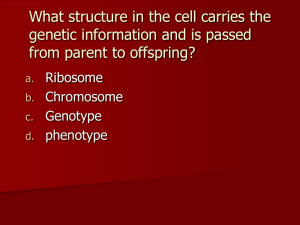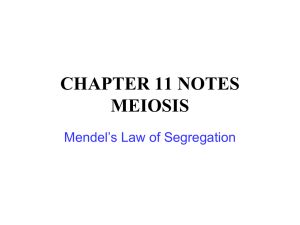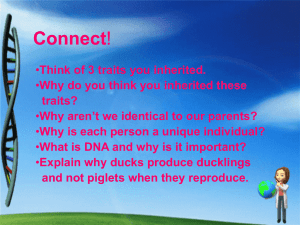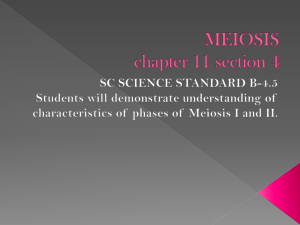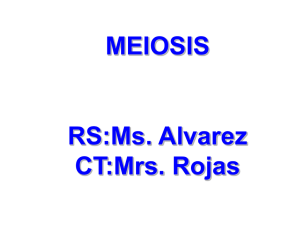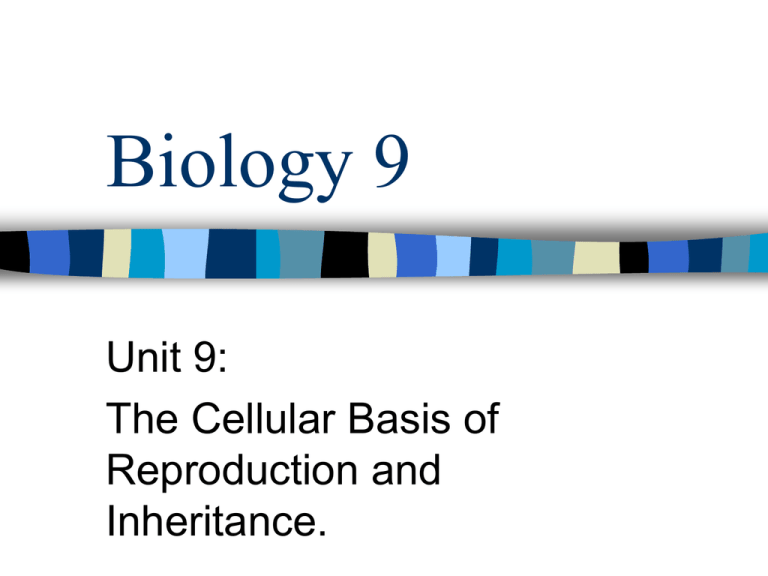
Biology 9
Unit 9:
The Cellular Basis of
Reproduction and
Inheritance.
Objectives: After completing this
Learning Quest the student will…
Create a step by step
diagram of how genes
pass from cell to cell.
Describe the cell cycles
and the process of
mitosis and meiosis.
Describe what happens
when abnormalities
occur in the meiosis.
Locate and describe
alternations of
chromosome structures.
Directions
1.
2.
3.
4.
Follow the instructions
in the Anticipation
Guide found in this
PowerPoint
Presentation.
Follow the instructions
and answer all
questions found in the
Learning Guide.
Follow the instructions
in the Conclusion
Guide.
ALL THREE GUIDES
CAN BE FOUND IN THIS
LEARNING
POWERPOINT QUEST.
Anticipation Guide (Page 1)
The center of the
cell not only controls
the cells activities
but it also initiates
and controls the
time when your
cell’s should
reproduce.
Learning Guide (Page 1)
During cell
reproduction, a cell
will divide into two
identical cells.The
original cell is called
a “parent” cell while
the two new
resulting cells are
called “daughter”
cells.
Learning Guide (Page 2)
Reproduction of single cell organisms occur
through a process known as asexual
reproduction.
Asexual reproduction does not require
fertilization of an egg by a sperm.Offspring
that are produced asexually can allow newly
formed daughter cells to inherit their
chromosomes from one parent cell.
Learning Guide (Page 3)
.
On the other hand, sexual
reproduction does involve
the fertilization of an egg
by a sperm. This process
involves a special type of
cell division/reproduction
called meiosis which only
occurs in reproductive
organs.
Learning Guide (Page 4)
Before we can talk
about the cell cycle
and cell division let’s
talk about
chromosomes.
Learning Guide (Page 5)
Chromosomes are
coiled up strands of
DNA that contain the
genetic material
required by the cell.
These chromosomes
are found within the
nucleus of all plant and
animal cells.
These chromosomes
will play an important
role in the development
of genetic
characteristics.
Learning Guide (Page 6)
Chromatin
Chromosomes are long
thread like structures
that are only visible
under the microscope.
In non-dividing cells,
chromosomes are seen
as a combination of
DNA and protein
molecules called
chromatin. As seen in
the diagram to the right.
Learning Guide (Page 7)
Notice that inside each
chromosome is one
long strand of DNA
super coiled up around
special proteins called
histones.
The 46 human
chromosomes found in
each one of our cells
contain an estimated 25
thousand genes.
Learning Guide (Page 8)
The passing on of
genetic information
from one cell to
another occurs when a
parent cell divides into
two daughter cells.
Mitosis is responsible
for creating body cells
that are “diploid”
because they contain
the full compliment of
chromosomes.
Humans have 46
chromosomes per cell.
The cell cycle diagram
to the right shows the
process your body
cells continually go
through.
Learning Guide (Page 9)
The Cell Cycle consists
of two major phases,
interphase and mitosis.
Interphase is the first
step of the cell cycle
where the chromosomes
make identical copies of
themselves. This
replication process
creates an exact set of
instructions to be
passed on to the new
cell.
During the mitotic phase
the duplicated
chromosomes will now
divide evenly among the
two daughter cells.
Learning Guide (Page 10)
The first step in the
cell cycle is called
Interphase. This is the
longest phase of the
cell cycle and
represents a normal
nondividing cell.
During interphase the
cell grows during the
G 1 phase, makes an
identical set of
chromosomes during
the S phase
(replication) and forms
an additional set of
organelles during the
G 2 phase.
Learning Guide (Page 11)
During the process of mitosis 4
additional steps take place. It
begins with a stage called
Prophase where the nucleus
disappears and spindle fibers
attach to the chromosomes that
are now visible.
Inside the nucleus the
chromatin fibers transform from
a disorganized group of fibers
to thick organized strands
called chromosomes viewable
with a light microscope.
Learning Guide (Page 12)
In the final part of
prophase the nuclear
membrane breaks
apart.This will allow the
microtubule spindles to
reach out and connect
to the chromosomes.
These protein fibers will
help move and
distribute the
chromosomes.
Learning Guide (Page 13)
During Metaphase,
the chromosomes
are positioned along
the middle of the
cell. Refer to the
diagram to the left
for the correct
placement of the
chromosomes.
Learning Guide (Page 14)
During Anaphase, the
chromosomes are
pulled to the opposite
ends of the cell. As a
result, an equal amount
of genetic
information/chromosom
es will be at each end
of the cell or the”poles”.
Learning Guide (Page 15)
During Telophase, each cell
will have received one half of
the chromosomes.
Telophase is the direct
opposite of prophase.
During Telophase, the
nuclear membrane begins to
reform as the chromosomes
unravel.
The final stage of cell
division is called cytokinesis.
During this stage the
cytoplasm and organelles
are divided between the two
daughter cells.
Learning Guide (Page 16)
The process where sexual reproduction of cells occur is called
Meiosis. Meiosis is responsible for creating sex cells/gametes
that contain only one half the chromosomes. These gametes
therefore are “haploid” (contain one half the chromosomes)
and are also genetically different from the parent cell.
During the life cycle living multicellular organism move through a
stages of life leading from the adult stage of one generation to
the adult stage of the next generation. Chromosomes also
follow through from one generation to the next however with
slight alterations between the generations.
Learning Guide (Page 17)
Humans are often known as diploid
organisms because all of our cells
contain two identical chromosomes.
The total number of chromosomes in
humans are 46. The exception to his
are the egg and sperm cells which are
known as gametes.
Learning Guide (Page 18)
Gametes, made by
a process called
meiosis, contain a
single set of
chromosomes. To
be exact, 22
autosomes and a
single sex
chromosome, either
X or Y.
Learning Guide (Page 19)
A cell that has a single chromosome set is known as a haploid
cell.
During sexual intercourse a haploid sperm cell fuses with the
haploid egg cell during the process called fertilization. The
results of this fertilized egg is called a zygote. This zygote now
is a diploid organism containing two sets of chromosomes, one
set from each parent.
The figure below demonstrates how meiosis creates chromates
used in the production of chromosomes for fertilization.
Learning Guide (Page 20)
The differences between Mitosis and Meiosis can be viewed in
the diagram below. As seen in the process of meiosis below the
parent cell will first create two haploid cells and then in the
Meiosis II the haploid cell divides again to create two more
haploid daughter cells.
Learning Guide (Page 21)
The figure to
the left
illustrates one
way the meiosis
process can
contribute to a
variety in the
genetic makeup
of a zygote.
Learning Guide (Page 22)
When a man and a
woman produce a
diploid zygote (a
child) there is
roughly 64 trillion
combinations of
chromosomes that
can take into effect.
Chromosomes can
also exchange
segments between
each of them during
the prophase of
meiosis. This
crossing over
process is
demonstrated in the
diagram to the left.
Learning Guide (Page 23)
Sometimes during the meiosis process an error can occur.
Chromosomes can make an extra copy or can forget to
make an extra copy.
In the figure below, there are three number 21
chromosomes. This condition is often called trisomy 21.
Learning Guide (Page 24)
A person who has a trisomy
21 chromosome condition is
said to have Down
Syndrome.
About one out of every 700
children born in the United
States are born with trisomy
21.
Trisomy and Down
syndrome can sometimes be
the results of women have
children later and later in life
(see graph to the right).
Learning Guide (Page 25)
A second type of chromosome accident that can occur
during meiosis is called nondisjunction.
During nondisjunction, a chromosome pair fail to separate
at anaphase. The results is an abnormal number of
chromosomes when gametes are produced.
Learning Guide (Page 26)
Nondisjunction does
not influence the
number of
autosomes such as
chromosomes 21,
however,
nondisjunction does
effect the number of
sex chromosomes.
An abnormal
number of sex
chromosomes
(extra X’s and Y’s)
can cause a
number of different
syndromes.
Learning Guide (Page 27)
Abnormalities in the
number of sex
chromosomes can
often cause disorders
dealing with either the
male or female
reproductive system
or even severe health
problems.
For further
information on
“Abnormalities
Numbers of Sex
Chromosomes”,
please read pages
136 to 138 of the
Essential Biology
textbook by
Campbell and
Reece.
Learning Guide (Page 28)
Males with the genetic disorder Klienfelter syndrome have an
extra copy of the X chromosome. This extra chromosome
creates a karyotype of 47 XXY. This abnormality is
associated with increased stature and long upper leg bones,
poor development of secondary sex characteristics and
infertility.
Learning Guide (Page 29)
Females with the disorder called Turner syndrome are missing one
copy of the X chromosome. When these babies are born, the
infants will have edema and poor muscle tone. Their survival after
birth may be influenced by the presence of major organ anomalies
including heart defects. Other anomalies may include a fold of skin
running from the neck to the shoulders; poor development of
secondary sexual characteristics; and untreatable infertility.
Learning Guide (Page 30)
Alternation of
chromosomes structure
can be various.
Parakeets, like many
living organisms
(including humans)
inherit a wide variety of
characteristics from
previous generations.
Learning Guide (Page 31)
Most often a pregnant women will be asked to have a
ultrasound scan of their baby. An ultrasound scanner can
produce high frequency sound waves. These sound waves
bounce off the fetus and the echoes produce an image on a
television monitor (see figure below).
To determine whether certain characteristics or chromosomes
have been passed from one generation to another human
beings can complete two tests: an Amniocentesis or a
Chorionic Villus Sampling (CVS).
Learning Guide (Page 32)
An amniocentesis process pulls fluid from the women’s
uterus. With this fluid doctors can determine whether there
are abnormalities in the chromosomes through a process
of karyotyping. This amniocentesis karyotyping takes
several weeks to produce results.
Learning Guide (Page 33)
The second type of test to determine abnormalities in the
chromosomes is through a chorionic villus sampling. During
the CVS process fetal cells are taken from a small piece of
fetal issue located on the placenta. By acquiring these cells
from the placenta the doctor completing the karyotyping will
only need a few hours rather than days to determine the
results.
Learning Guide (Page 34)
Alternative forms of genes that can be produced from a parent
are called alleles.
Flowers and green plants that produce offspring like that of the
pea plant normally have only two alleles.
Human blood often has multiple alleles. The three alleles for the
characteristic of ABO blood type can produce four phenotypes.
These four phenotypes are O,A, B, or AB (Also refer to as blood
types).
Learning Guide (Page 35)
Another example of alteration in alleles is in human
hypercholesterolema. Here the dominate allele (HH)
specifies a cell surface protein called an LDL receptor.
Heterozygotes (Hh) have only half the normal number of
LDL receptors. Finally, homozygotes (hh) have none.
Have little or no LDL receptors can allow for dangers
levels of LDL to build up in the blood.
Learning Guide (Page 36)
People who have
homozygous for
the sickle-cell
allele will have
sickle-cell disease.
Sickle-cell disease
will cause red
blood cells to
become sickle
shaped. Sicklecell disease can
often lead to other
health problems
(see figure to the
left).
Learning Guide (Page 37)
Finally, color
blindness,
hemophilia and
many other
disorders can be
determined by sex
linked genes
passed along by
both men and
women.
Above: A common test for
red-green color blindness.
Conclusion Guide (Page 1)
Practice Assessment 1: The diagram
below shows cells in various phases of the
cell cycle. On your notebook paper answer
the questions on the following slides.
Conclusion Guide (Page 2)
1.
2.
3.
4.
5.
Sequence the six diagrams in order from first to last.
Which cell is in metaphase?
Cells A and F show an early and late stage of the same
phase of mitosis. What phase of mitosis is it?
In cell A, what structure is labeled X?
In cell F, what structure is labeled Y?
Move onto the next slide!
Conclusion Guide (Page 3)
6.
7.
8.
Which cell is not in a phase of mitosis?
What two main changes are taking place in cell B?
What are the main differences between cytokinesis
in plant cells and in animal cells?
Conclusion Guide (Page 4)
Practice Assessment 2: Match the definition in Column A
with the term in Column B.
Column A
1.
2.
3.
4.
5.
6.
7.
8.
The different forms of a gene.
The alleles present for a trait are the same.
A cell that contains one member of each
chromosome pair.
The type of cell division that produces
gametes.
The cell produced when a lae gamete
fuses with a female gamete.
The uniting of the male and female
gametes.
The exchange of genetic material between
homologous chromosomes.
The failure of homologous chromosomes
to separate properly during meiosis.
Column B
a.
b.
c.
d.
e.
f.
g.
h.
Crossing over
Homozygous
Fertilization
Meiosis
Nondisjunction
Zygote
Haploid
Alleles
Conclusion Guide (Page 5)
Practice Assessment #3: Write the letter of the word or phrase that
best completes the statement.
1.Pollination can best be described as
a. the fusing of the egg nucleus with the pollen nucleus.
b. the transfer of a male pollen grain to the pistil of a flower.
c. the formation of male and female sex cells.
d. the type of cell division that produces diploid gametes.
2.The gamete that contains genes contributed by the mother is.
a. A sperm.
b. an egg. c. a zygote. d. dominant.
3. Cell containing two alleles for each trait are described as.
a. haploid b. gametes
c. diploid
d. homozygous
Works Cited
http://www.wpic.pitt.edu/research/sweetlab/Chromosomes.jpg
http://www.niapublications.org/pubs/pr01-02/images/large/chromosomes.jpg
http://www.alken-murray.com/CellDiv.jpg
http://scied123.ed.hiroshimau.ac.jp/seaurchin/picture/2cell1.jpghttp://www.lampstras.k12.pa.us/hschool/teach
ers/pitts/bio/un11/interphase.jpg
http://www.koshlandscience.com/exhibitdna/images/dna/intro02.gif
http://employees.csbsju.edu/hjakubowski/classes/ch331/dna/chromosomes.gif
http://gslc.genetics.utah.edu/units/disorders/karyotype/images/trisomy21_karyot
ype.jpg
http://biology.queensu.ca/~dosenl/3%20budgies.jpg
http://www.healthsystem.virginia.edu/internet/women/tours/primarycare/ultrasou
nd.jpg
After completing the test, see your teacher
for further instructions and to complete
your final exam.





